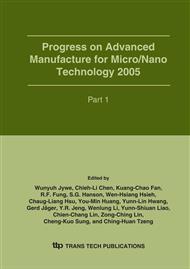p.109
p.115
p.121
p.127
p.133
p.139
p.145
p.151
p.157
Length Effect on Formation of Metallic Patterns by Nanoimprinting Process – Molecular Dynamics Simulation
Abstract:
The nanoimprinting process between a nickel mold and a gold thin film consisting of 9500 – 11000 atoms was studied using molecular dynamics computational simulation. The nickel mold and the gold thin film were both formed in face central cubical (FCC) single crystal, and the simulation condition was in an isothermal state of 300K. The Morse potential was utilized in order to determine interatomic forces and potentials. During the nanoimprinting process, jump-to-contact, thin-film recovery, slip-line like, dead-metal zone and dislocation phenomena were observed. After finishing nanoimprinting processes, the interactive force curves between the mold pattern and thin film, and those inside the thin film were measured. By varying the pattern width of the mold and incorporating the measured force curves inside the thin film, the length effect on metallic pattern formation can be determined. In addition, through analytical investigation, it can be observed that the thin-film thickness, the pattern width of the mold, and the applied force should be matched up very well in order to obtain good formation of metallic pattern.
Info:
Periodical:
Pages:
133-138
Citation:
Online since:
January 2006
Authors:
Keywords:
Price:
Сopyright:
© 2006 Trans Tech Publications Ltd. All Rights Reserved
Share:
Citation:


